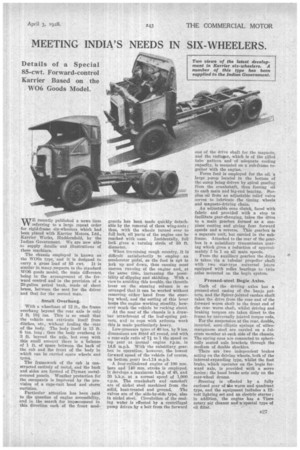MEETING INDIA'S NEEDS IN SIX-WHEELERS.
Page 61

If you've noticed an error in this article please click here to report it so we can fix it.
Details of a Special 85-cwt. Forward-control Karrier Based on the W06 Goods Model.
W. E recently published a news item referring to a large repeat order for rigid-frame six-wheelers which had . been placed with Karrier Motors, Ltd., Karrier Works, Huddersfield, by the Indian Government We are now able to supply details and illustrations of these machines.
The chassis employed is known as the W06a type, and it is designed to carry a gross load of 85 cwt. It is similar in many respects to the standard W06 goods model, the main difference. being in the arrangement of the forward control and in the provision of a 20-gallon petrol tank, made of sheet brass, between the seat for the driver and that for the second man.
Small Overhang.
With a wheelbase of 12 ft., the frame overhang beyond the rear axle is only
2 ft Di ins. This is so small that the vehicle can extricate itself from ditches, etc., without fouling the rear of the body. The body itself is 13 ft. 6 ins. long ; thus the body overhang is 3 ft. beyond the axle, but even with this small amount there is a alance of 1 ft. of space between the back of the cab and the front of the body in which can be carried spare wheels and tyres.
The framework of the cab is constructed entirely of metal, and the back and sides are formed of Plymax metalcovered panels. Weather protection for the occupants is improved by the provision of a cape-cart hood and storm' curtains.
Particular attention has been -paid to the question of engine accessibility, and in the search for impaovement in this direction each of the front mud
guards has been made quickly detachable by the removal of three wing-nuts; thus, with the wheels turned over to full lock, all parts of the engine can be reached with ease. Incidentally, full lock .gives a turning circle of 58 ft. diameter.
When traversing rough country, it is difficult satisfactorily to employ an accelerator pedal, as the foot is apt to jerk up and down, thus causing most uneven running of the engine and, at the same time, increasing the possibility of slipping and skidding. With a view to avoiding this trouble, the throttle lever on the steering column is so arranged that it can be worked without removing either hand from the steering wheel, and the setting of this lever keeps the engine working steadily, however much the vehicle be rocking aboht At the rear of the chassis is a drawbar attachment of the leaf-spring pattern, and to cope with arduous work this is made particularly heavy.
Low-pressure tyres of 40 ins. by 9 ins. dimensions are fitted all round, and with a rear-axle ratio of 71 to 1 the speed on top gear at normal engine r.p.m. is 14.6 m.p.h. With the subsidiary gearbox in operation, however, the lowest forward speed of the vehicle (of course, on bottom gear) is.1.14 m.p.h.
A four-cylindered engine of 100 mm, bore and 140 mm. stroke is employed. it develops a maximum b.h.p. of 48, and 30 b.h.p. at a normal speed of 1,000 r.p.m. The crankshaft and camshaft are of nickel steel machined from the
solid, beat-treated and ground, The valves are of the side-by-side type, also in nickel steel.. Circulation of the cooling water is effected by a centrifugal pump driven by a belt from the forward end of the drive shaft for the magneto, and the radiator, which is of the gilled tube pattern and of adequate cooling capacity, is mounted on a sub-frame together with the engine.
Force feed is employed for the oil, large pump located in the bottom of the sump being driven by spiral gearing from the crankshaft, thus forcing oil to each main and big-end bearing. Surplus oil frcini an adjustable relief valve serves to lubricate the timing wheels and magneto-driving chain.
An adjustable cone clutch, faced with fabric and provided with a stop to facilitate gear-changing, takes the drive to a main gearbox formed as a onePiece casting and giving four forward speeds and a reverse. This gearbox is a separate unit, but carried in the subframe. Attached to the rear of the gearbox is a subsidiary transmission gearing which gives a reduction of approximately 3 to 1 on all main speeds.
From the auxiliary gearbox the drive is taken via a tubular propeller shaft with two star-type universal joints equipped with roller bearings to twin axles mounted on the bogie system.
Pressed-steel Bogie Axles.
Each of the driving axles has a pressed-steel casing of the banjo pattern, and the Spicer-jointed cardan shaft takes the drive from the rear end of the forward worm shaft to the front end of the rear worm shaft, whilst driving and braking torques are taken direct to the frame by universally jointed torque rods.
For the suspension at the rear, double, inverted, semi-elliptic springs of since,manganese steel are carried on a fulcrum member at each side of the chassis. The spring eyes are connected to spherically seated axle brackets through the medium of double shackles.
There are two independent brakes acting on the driving wheels, both of the internal-expanding type, whilst the foot brake, 'which operates on the bogie forward axle, is provided with a servo device; the hand brake acts only on the rear-wheel drums.
Steering is effected by a fully enclosed gear of the worm and quadrant type, and the equipment includes a 12volt lighting set and an electric starter ; in addition, the engine has a Visco rotary air cleaner and a,speeial type of oil filter.




















































































































